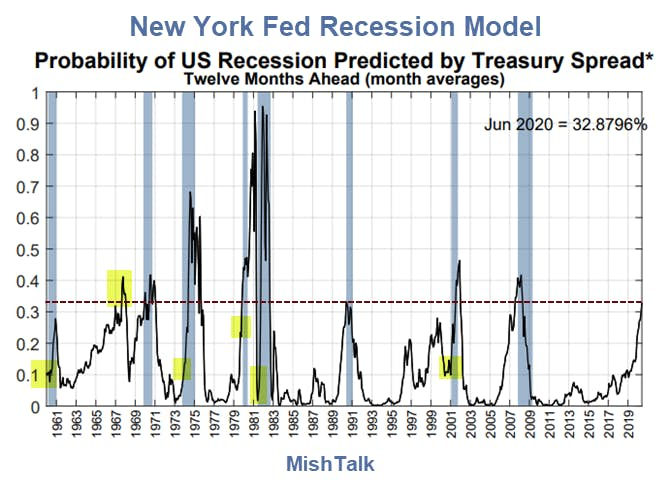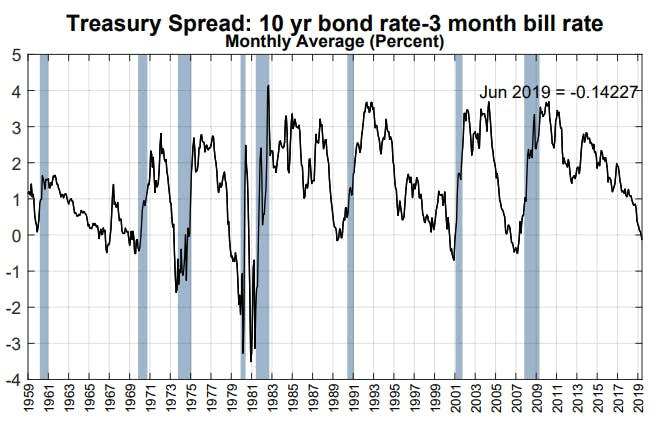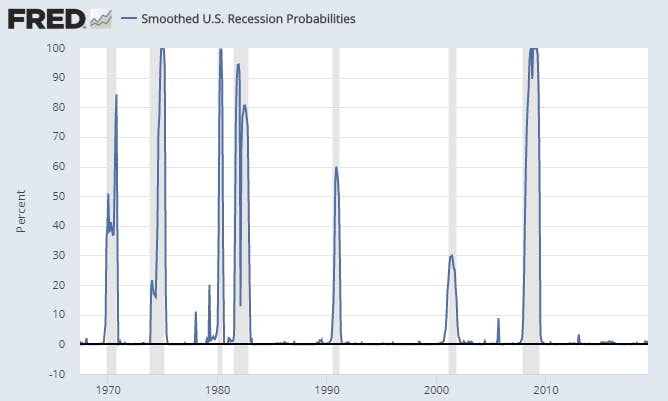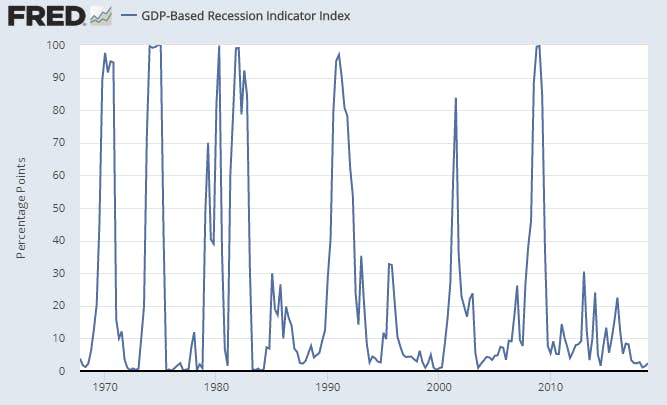The New York Fed has the odds of a recession within the next year at 33%. Some of the other models are humorous.
New York Fed Treasury Spread Model
The New York Fed Recession Model is based on yield curve inversions between the 10-year Treasury Note and the 3-Month Treasury Bill.
I added the highlights in yellow and the dashed red line.
The model uses monthly averages.
Smoothed Recession Odds
I do not know the makeup of the smoothed recession chart but it is clearly useless. The implied odds hover around zero, and are frequently under 20% even in the middle of recession.
GDP Recession Model
The GDP-based recession model is hugely lagging. The current estimate is 2.4%. This model will not spike until there is at least one quarter of negative or near-zero GDP.
Estimated Recession Probabilities
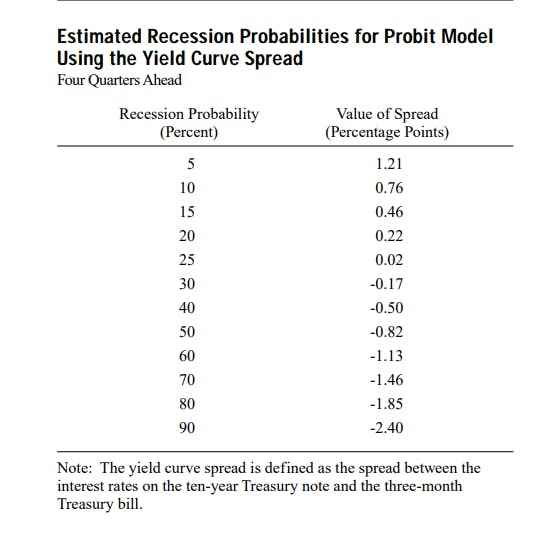
Predicting Recessions
The above chart is from the Yield Curve as a Predictor of U.S. Recessions by Arturo Estrella and Frederic S. Mishkin. It is from 1996 so the table may have been revised.
Practical Issues
One might also wish to consider the 2006 discussion the Yield Curve as a Leading Indicator: Some Practical Issues.
With regard to the short-term rate, earlier research suggests that the three-month Treasury rate, when used in conjunction with the ten-year Treasury rate, provides a reasonable combination of accuracy and robustness in predicting U.S. recessions over long periods.
Maximum accuracy and predictive power are obtained with the secondary market three-month rate expressed on a bond-equivalent basis, rather than the constant maturity rate, which is interpolated from the daily yield curve for Treasury securities.
Spreads based on any of the rates mentioned are highly correlated with one another and may be used to predict recessions. Note, however, that the spreads may turn negative—that is, the yield curve may invert—at different points and with different frequencies.
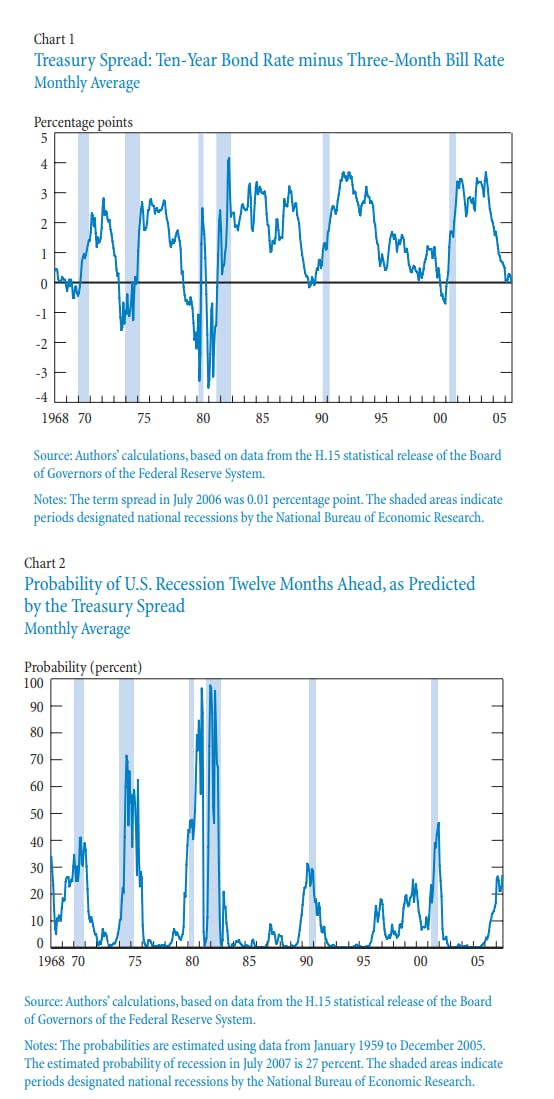
Our preferred combination of Treasury rates proves very successful in predicting the recessions of recent decades. The monthly average spread between the ten-year constant maturity rate and the three-month secondary market rate on a bond equivalent basis has turned negative before each recession in the period from January 1968 to July 2006 (Chart1). If we convert this spread into a probability of recession twelve months ahead using the probit model described earlier (estimated with Treasury data from January 1959 to December 2005), we can match the probabilities with the recessions (Chart 2). The chart shows that the estimated probability of recession exceeded 30 percent in the case of each recession and ranged as high as 98 percent in the 1981-82 recession.
Other Spreads
The article mentions "The ten-year minus two-year spread tends to turn negative earlier and more frequently than the ten-year minus three-month spread, which is usually larger."
That is certainly not the case today.
The 2-year yield is 1.882 whereas the 10-year yield is 2.041.
Chalk this up to QE, Fed manipulation, taper tantrums, and hedge funds front-running expected rate cut moves.
This material is based upon information that Sitka Pacific Capital Management considers reliable and endeavors to keep current, Sitka Pacific Capital Management does not assure that this material is accurate, current or complete, and it should not be relied upon as such.
Recommended Content
Editors’ Picks

AUD/USD: Further gains need more conviction
AUD/USD reversed two-daily pullbacks in a row on Tuesday, staging a decent comeback from Monday’s troughs near 0.6220 to the boundaries of the 0.6300 hurdle propped up by the RBA hawkish hold and firm data from Chinese business activity.
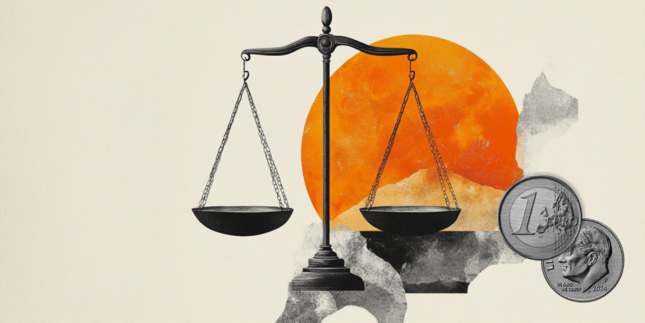
EUR/USD remains offered below 1.0800 ahead of “Liberation Day”
EUR/USD came under extra downside pressure on Tuesday, returning to the sub-1.0800 region on the back of tepid gains in the US Dollar and rising caution prior to Trump’s announcements on Wednesday.

Gold nears $3,100 as fears receded
Gold is easing from its fresh record high near $3,150 but remains well supported above the $3,100 mark. A generalised pullback in US yields is underpinning the yellow metal, as traders stay on the sidelines awaiting clarity on upcoming US tariff announcements.

Bitcoin just as vulnerable as major assets – Anthony Yeung, Global Head of Strategic Development at CoinCover
Bitcoin trades under the $85,000 mark, holding on to nearly 3% gains on Tuesday ahead of Donald Trump’s Liberation Day. Crypto traders remain fearful, the sentiment reads 34 on a scale of 0 to 100 on the Fear & Greed Index.

Is the US economy headed for a recession?
Leading economists say a recession is more likely than originally expected. With new tariffs set to be launched on April 2, investors and economists are growing more concerned about an economic slowdown or recession.

The Best brokers to trade EUR/USD
SPONSORED Discover the top brokers for trading EUR/USD in 2025. Our list features brokers with competitive spreads, fast execution, and powerful platforms. Whether you're a beginner or an expert, find the right partner to navigate the dynamic Forex market.
